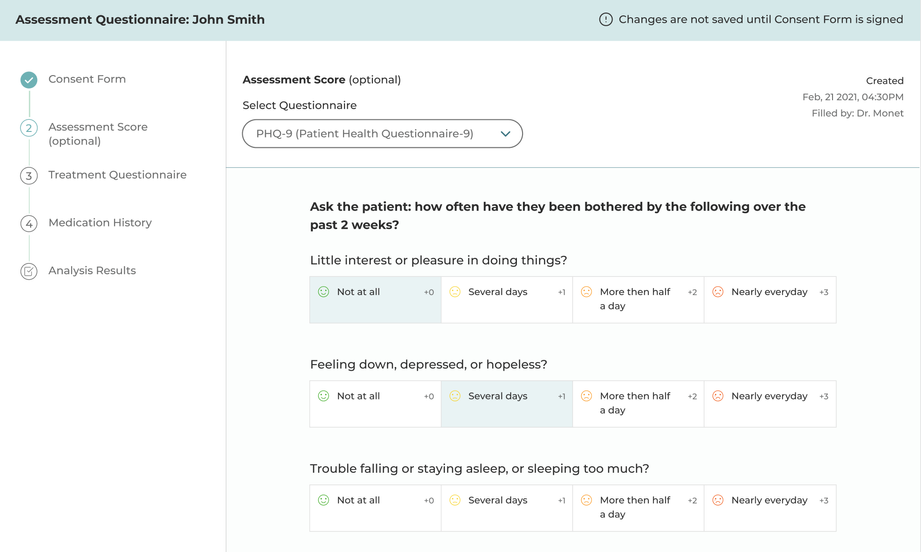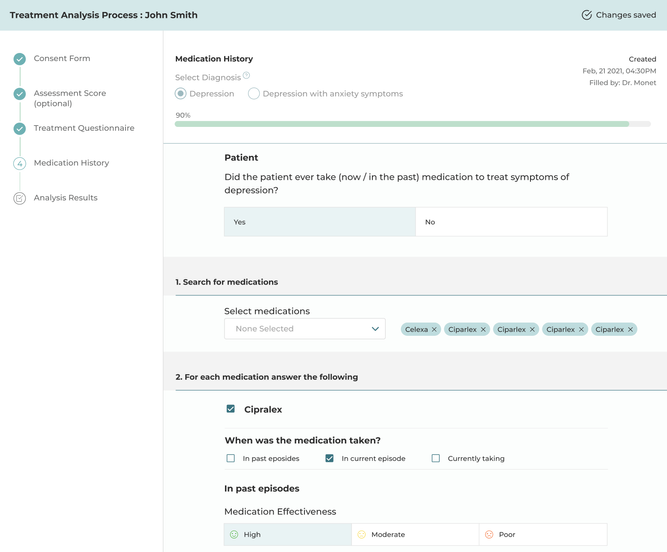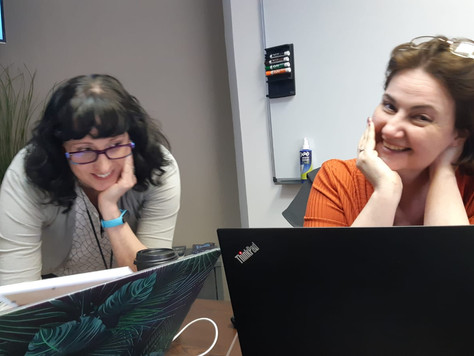A MedTech Platform for Treating Anxiety
- sivanadesign

- 16 בנוב׳ 2024
- זמן קריאה 4 דקות

Project Overview
Predictix is an innovative MedTech product from Taliaz Startup in Israel, enhancing medication prescription accuracy for patients with anxiety and depression through statistical algorithms and machine learning.
80% of antidepressants are prescribed by Primary Care Physicians with limited success tools.
Selection from multiple antidepressants.
Limited consultation time of 10-15 minutes.
Prescription accuracy ranging from 30% to 49%.
Traditionally, finding the right medication takes months of trial and error, causing side effects, rapid changes, and eroding trust in the medical team
Taliaz's solution focused on
Enhancing prescription accuracy
Reducing the time required to find the right medication
Equipping doctors with data tracking and insights for educated data-driven decisions

My Role
User Experience Consultant (Research & Strategy)
When
2021
Team
Inhouse Team: VP Product, Outsourced Development Team, Data Analysts Team
Product Designer: Anat Ganot
Tools used
Asana
Miro
Figma

My mission
Research the needs and motivations of Potential Design Partners for initial launch.
Help the team Develop and test a working MVP for doctors treating patients with anxiety and depression.
Project Planning
In this dynamic process, I ensured early clarity by aligning stakeholders through a project strategy that would follow the research stage.
This was vital as we conducted Research, created Wireframing, and defined UI guidelines simultaneously with third-party branding of the company.
We used Asana to build a road map and create a clear path toward the completion of the project.

Research
The research involved three key steps:
Collect: Gathering team assumptions and requirements.
Validate: Gaining insights through Qualitative Research to confirm we address the right problems.
Explore: Investigating existing solutions and current practices.
1. Collect
When the customer came for help, they had a working but complex platform that doctors found frustrating to use.
Based on my experience with startups, I know the importance of not reinventing the wheel.
I mapped the current POC, pinpointed usability issues, and provided insights for moving forward

Where are the critical pain points?
I used User Journey mapping to move the conversations from a list of screens to a flow,
with tasks and motivations.

Who is this for?
After mapping the POC and integrating PRD insights, we dove into understanding our users. Using proto-personas, the VP and CEO filled out templates, and in a session, we explored their needs via an empathy map.
By mapping team assumptions, we crafted a focused research plan to address key validation points for product and interface improvements and provide valuable business insights.
2. Validate
With this in mind, I crafted a research plan. I analyzed recorded conversations with Doctors who were Design Partners and MVP testers.
I also conducted additional 1:1 interviews for deeper insights.

Here is what we've learned
After validating pain points and opportunities, I provided key insights: Doctors lack time for questionnaires and prefer pre-session patient input. The initial doctor-patient conversation is crucial; questionnaires confirm the severity.
I streamlined the system architecture and recommended a user-friendly, clear user journey.

By validating and debunking the Team's assumptions about the users,
we could move forward, creating an improved flow for the platform and the journey of users in it because we built trust.
3. Explore
My exploration research focused on two main needs:
Functionality & Terminology: We explored how various actions for doctors are presented in similar systems to verify best practices.
Reports and Statuses: We looked for reports and dashboards for doctors, which provided answers regarding medication for patients.
Brainstorming and Ideation
We worked alongside the Product VP and Dev team to discuss possible flows and layouts for each screen in the flow.
I love working with Miro or other collaboration tools since it allow me to open a whiteboard and sketch the Low-Resolution wireframe with my team.
But Wait... It's Not All Smooth Sailing
Sometimes, you need to improvise
While working on a report screen, the team disagreed on organizing data in the table for doctors.
I invited my team to a "Card Sorting" session, where we broke down the table's content and actions, sorted and prioritized them individually, and then converged as a group to make decisions.

After 1 Hour of collaborative work with a bit of Design-Thinking, we got to an agreement and were able to move forward 🤩
User-Centered Design in Action
For this project, I teamed up with a colleague. She was responsible for the Design part, and I owned the Strategy, Research, and UX deliverables.
Entry point to the platform
Adding a new Patient to the system
In a health-focused platform, we navigated regulations and addressed patient consent forms. Clear micro-copy, friendly errors, notifications, and user choice created a complex yet accessible path for our Doctors.
Intake questionnaire
To ensure precise medication recommendations, Doctors completed a diagnostic questionnaire following standard practices for anxiety and depression diagnosis.
I streamlined this process by learning the domain and collaborating with data scientists while adhering to medical regulations.
Patient's treatment efficiency over time
Tracking prescription effectiveness is vital for treatment success. We designed a dashboard to showcase follow-up session data between doctors and patients.

Testing & Validation
After defining our flow and mockups, I held a team session to identify potential questions and ensure buy-in from Sales, Data Analysts, and Marketing team members. This session also helped spot potential blind spots for user validation.
Subsequently, I created a Usability Test plan and conducted 1:1 Moderated remote chats on Zoom, with the VP and PD as note-takers.
Testing, Validation & Conclusion
Reflecting on my journey as a professional UX Researcher and Strategist in this incredible project, I realize there's so much I've learned and countless heights I've scaled.
But if I were to distill it down, here are my key takeaways:
Above all, I've come to appreciate the immense value of positively impacting people's lives through my work.
Without a doubt, I've witnessed firsthand that the foundation of any successful solution is the magic that happens when a great team collaborates.
Once that's in play, everything else naturally falls into place.















































